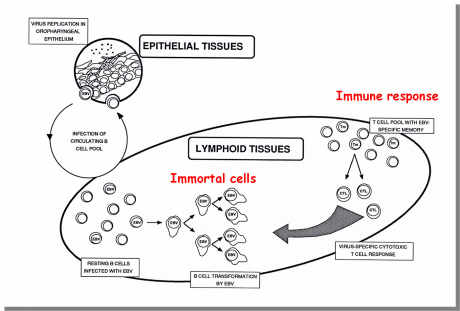General description of West lab research for the non-specialist
The research in our laboratory aims to understand how the cancer-associated virus Epstein-Barr virus (EBV) causes cancer and develop new drugs to help treat it. By investigating the detailed molecular mechanisms involved, we hope to obtain new information that will help our understanding of how cells become cancerous and identify new potential targets that can be used in the development of agents to treat EBV-associated diseases. We are alos developing new drugs that target one of the essential proteins porduced by the virus in cancer cells
History and backgroud to EBV
EBV was the first virus to be linked to the development of human cancer. This cancer, Burkitt's lymphoma, occurs with highest frequency in children aged between 6 and 8 years in sub-saharian Africa and normally develops as a tumour growth in the jaw, eye or abdomen. In 1964, Tony Epstein working together with Yvonne Barr, discovered that cells derived from Burkitt's lymphoma samples contained virus particles that resembled previously identified herpesviruses and EBV was described as new member of the herpesvirus family that possessed cancer-promoting properties.
EBV has now been shown to cause a number of other lymphomas including Hodgkin's disease, lymphomas in children and adults that have had bone marrow or solid organ transplants and lymphomas in HIV-positive patients suffering from AIDs. EBV is also a key factor in the development of the non-lymphoid cancer nasopharyngeal carcinoma, a cancer common in southern China and southeast Asia.
EBV normally infects a particular type of white blood cell, the B lymphocyte or B-cell, but can also infect another type of non-blood cell, the epithelial cell. The life span of a B-cell is usually only a few weeks, but when infected with EBV, these cells can grow indefinitely and are termed immortal. The ability of the virus to create immortal cells is the key to its cancer promoting properties.
 EBV infects epithelial cells in the back of the throat and B-cells passing through this tissue. B-cells are immortalised and carry the virus as a dormant or latent infection. The immune system controls EBV infection as a result of T-cells recognising and destroying infected cells.
EBV infects epithelial cells in the back of the throat and B-cells passing through this tissue. B-cells are immortalised and carry the virus as a dormant or latent infection. The immune system controls EBV infection as a result of T-cells recognising and destroying infected cells.
Despite its strong association with cancer development, EBV is a very common virus and infects over 95% of the world's population. Since all EBV infected individuals do not develop EBV associated cancers, it must be possible for EBV infection to be tolerated and controlled. In fact, our immune system is usually very good at recognising and destroying large numbers of EBV infected cells, thus preventing cancer development. EBV survives by hiding from the immune system and can remain in a dormant (latent) state in infected B-cells where it produces only a small number of essential virus proteins. From time to time, EBV is triggered to produce more virus particles by entering its lytic phase. This allows EBV to infect new cells and be passed on to new individuals.
Most of us become infected with EBV during childhood as a result of virus being passed on through saliva, usually during kissing or sharing of food and utensils. Infection at this age has no symptoms and we are unaware that we have been infected. Our immune system then prevents the growth of large numbers of EBV infected cells and cancer development, despite the fact that B-cells infected by EBV are immortal. If EBV is not encountered until later in life, for example as a teenager, infection can result in glandular fever (infectious mononucleosis) in 30-50% of individuals. The symptoms of glandular fever are the result of an excessive immune response to the infection and the disease can be lengthy and debilitating.
Our research
Our research aims to determine how EBV infection causes a B-cell to become immortal. Understanding how this happens provides important information on how EBV-associated cancers develop, but also helps us to understand how a cell changes from a normal cell with a defined life span to one that grows indefinately. This information is very important for the study of all types of cancer and can help in the develoment of strategies to treat and prevent this disease.
When EBV infects a B-cell, it produces a small number of viral proteins (9 in total). Our research focuses on how a key set of 4 of these proteins switch on genes that push the cells to grow indefinately and switch off genes that can trigger cell death. We have shown that these EBV proteins take control of cell genes by hijacking gene 'control centres' found at long distances from the genes themselves and alter the contacts formed between these control centres and the genes.
Our work also focuses on another EBV protein that is required for the virus to replicate its DNA and for EBV cancer cells to survive. This is the target of the new drugs we are developing to help increase the number of patients who survive EBV cancers, but also to generate new less toxic and targeted therapies that only kill the cancer cells so treatments are less harsh.
We have also discovered that a protein that promotes cell growth (RGC-32) found in high levels in many cancer cells, is also produced in high levels in EBV-infected cells. We are currently investigating how this protein is produced in EBV infected cells and how it contributes to their sustained growth.


